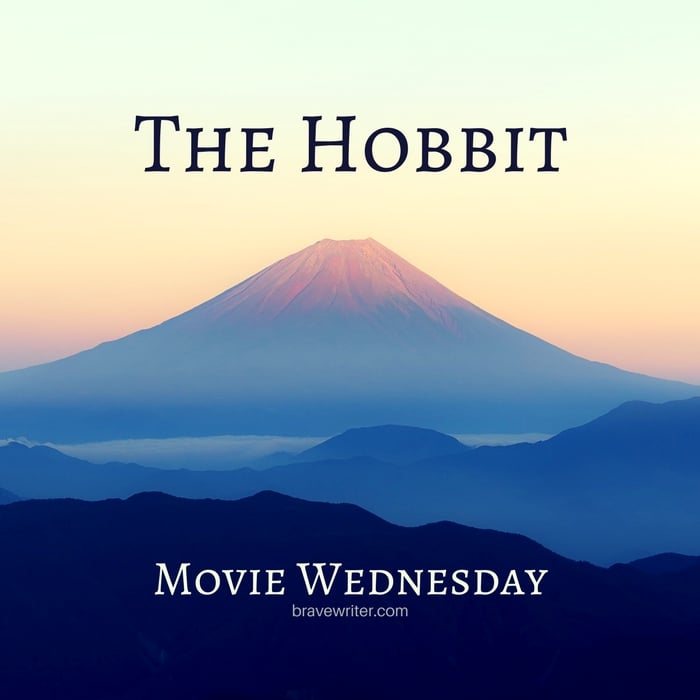Movie Wednesday: The Hobbit

by Amy Frantz, Brave Writer alum
Bilbo Baggins is a Hobbit who values his ordinary life filled with ordinary comforts. But one day the wizard Gandalf puts a mark on Bilbo’s door and a company of thirteen Dwarves shows up on Bilbo’s doorstep. The Dwarves, led by Thorin Oakenshield, have set out to retake their home which they were driven from many years ago by a fire-breathing dragon. The company wants Bilbo to be their burglar and help them take back their home and the treasures within it. Bilbo is quickly sucked into a world of adventure, danger, haunted woods, trolls, and dragons, and he begins to discover that perhaps he’s not so ordinary after all.
[This post contains Amazon affiliate links. When you click on those links to make purchases,
Brave Writer receives compensation at no extra cost to you. Thank you!]
The Hobbit, or There and Back Again, by J.R.R. Tolkien was first published in 1937. Although considered by some a “prequel” to the later published Lord of the Rings, the Hobbit was initially a separate story in its own right. It has gone on to be widely considered a classic both of children’s literature and high fantasy.
The Hobbit has been adapted many times over the years, one of the most recent additions being the film trilogy directed by Peter Jackson. The three films are titled:
The Hobbit Trilogy draws not only from Tolkien’s original novel, but also from material in the appendices of the third Lord of the Rings installment, the Return of the King, as well as original material created for the film.
At first intended to be a duology, the films were expanded into a trilogy with additional scenes filmed and added in. All three movies were filmed in 3D and have a higher frame rate giving the films a distinctive, clear, and “glowing” quality.
A note to parents: All three installments in the Hobbit Trilogy are rated PG-13. We recommend looking up the films on sites like Commonsense Media before deciding if they are right for your family.
Discussion Questions
- It has often been noted that the Hobbit novel does not feature any female characters. The film trilogy adds the female Woodland Elf Tauriel, a completely new character unique to the movies, and also features Galadriel, a character from Lord of the Rings. What do you think Tauriel and Galadriel’s presence adds to the story?
- Do you have a favorite Dwarf in the company? How do you think the story might be different if it was told from that character’s point of view instead?
- After the Dwarves retake Erebor, Thorin begins covetously hoarding his gold and grows suspicious of his friends and comrades. Near the end of the final film after overcoming his “dragon sickness,” Thorin reflects that “If more people valued home above gold, this world would be a merrier place.” What do you think the story may be trying to say about greed and materialism?
- At the beginning of An Unexpected Journey, Bilbo is none too happy to have his quiet evening crashed by the Dwarves. How do you think you would react if you were in Bilbo’s position?
Additional Resources
The Hobbit Learning Resources and Activities
 Learn language arts with the Hobbit Boomerang!
Learn language arts with the Hobbit Boomerang!
The Boomerang is a monthly digital downloadable product that features copywork and dictation passages from a specific read aloud novel. It is geared toward 8th to 10th graders (ages 12—advanced, 13-15) and is the indispensable tool for Brave Writer parents who want to teach language arts in a natural, literature-bathed context.

















